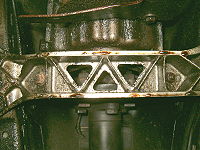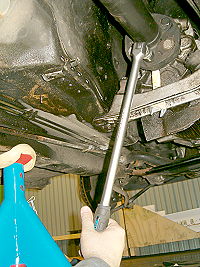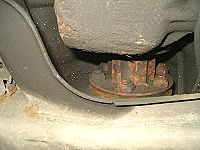Removing Driveshaft
The driveshaft have just three mounting points. It is connected to the output
flange of the gearbox, connected to the input flange of the final drive and in
the middle it is supported by a center bearing.
Step 1 : Towards The Gearbox
Start by unmounting the driveshaft at the output flange of the gearbox. In
between the gearbox and driveshaft there is a rubber flex disc (guibo) with
the purpose to absorb torsional vibrations from the engine/transmission
and to reduce shock load to the driveshaft and rear axle.
My first intention was to unmount the rubber flex disc from the gearbox and
remove the driveshaft and rubber flex disc in one piece. But it turned out that
could not reach the nuts in an appropriate way to do so. So I decided to leave
the rubber flex disc on the gearbox and only remove the driveshaft.

Driveshaft and rubber flex disc connected to the gearbox. The arrows points out
the screws (and nuts on the other side) to be removed if you choose to leave the
rubber flex disc on the gearbox.
The basic idea is to insert a box-end or open-end wrench through one of the three
holes in the transmission cross member and use it as a counterhold when you loosen
the screws.

The three holes on the transmission cross member.
When you have placed your counterhold wrench (tips is to let the wrench have the
cross member as it's own counterhold so you can concentrate on the screw) then
use a long breaker bar and a socket (a 1/2" 6-point socket and a 1/2" 500 mm long
braker bar is recommended) to undo the screw. Remove completely all three pair
of screws and nuts before proceeding to the other end of the driveshaft. Note that
all nuts and screws are 19 mm hex heads.

Use a box-end or open-end wrench on the nut as a counterhold and a long breaker bar
to undo the screw.
Since it is limited space you have to rotate the driveshaft until you get
a good grip of a nut. To rotate the driveshaft simply put the gearbox into
neutral, raise one of the rear wheels from the ground and turn it. This only
works on cars with open differential, if your car is equipped with limited slip
differential (or AGA differential!) you have to get both rear wheels of the
ground.
|
Step 3 : Towards The Final Drive
Next step is to remove the driveshaft from the final
drive (rear differential). The connection between the
driveshaft and the final drive consists of a CV joint
(constant velocity). The driveshaft with the CV joint
at the end is connected to the final drive input flange
with six pin screws and 17 mm sex head self-locking nuts.
The nuts are are accessible from an opening in the rear
subframe. Use a long 17 mm box-end wrench to undo the
nuts (there is no place for a socket).

The six 17 mm sex head nuts accessible through the
hole in the rear subframe.
You can only access and undo two nuts at a time.
To access the next pair of nuts you have to raise one
rear wheel and rotate it until you can reach the next
pair. Don't forget to put the gearbox into neutral and
if you have a limited slip differential you have to
raise both rear wheels from the ground.
If you have an old car, like me, you might discover
that you can not undo the nuts but instead you undo the
pin screw and nut in one piece. This happened to me but
it does not makeany big difference. It will work just
as fine anyway.
Step 4 : Towards Center Bearing And Removal
The final mounting point is the center bearing support.
This is mounted with two 13 mm hex head screws. Before
removing you shall support the driveshaft with for example
a floor jack or similar.

Center bearing support held by two 13 mm hex head screws.
With the center bearing support removed you carefully push
the driveshaft backwards (sliding the driveshaft together at
the splined coupling) and pull it off at the front (against
the gearbox). Now simply pull it off at the end (against the
final drive). You might experience some resistance when trying
to get it off from the final drive due to a sealing holding the
two parts quite good together. Just use a tire bar or similar
and give it a push on one of six screws you can access through
the hole of the rear subframe.

The removed driveshaft.
If everything went well you should now have one nice and
shiny driveshaft lying on your garage floor!
Use care when removing and handling the driveshaft. Never let
the yokes of the U-joint at the middle of the driveshaft to lock
themselves (especially under load) otherwise you can damage the
U-joiunt.
In next part we start removing the gearbox!
|

